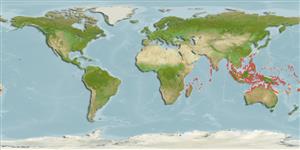Common names from other countries
>
Eupercaria/misc (Various families in series Eupercaria) >
Scaridae (Parrotfishes) > Scarinae
Etymology: Scarus: Greek, skaros = a fish described by anciente writers as a parrot fish; 1601 (Ref. 45335).
More on author: Valenciennes.
Environment: milieu / climate zone / depth range / distribution range
Ecología
marino asociado a arrecife; rango de profundidad 2 - 18 m (Ref. 9710). Tropical; 30°N - 24°S
Indo-West Pacific: India to Vanuatu, north to the Ryukyu Islands, south to New Caledonia; Palau (Belau) in Micronesia.
Tamaño / Peso / Age
Maturity: Lm ? range ? - ? cm
Max length : 40.0 cm TL macho / no sexado; (Ref. 48636)
Short description
Claves de identificación | Morfología | Morfometría
Espinas dorsales (total) : 9; Radios blandos dorsales (total) : 10; Espinas anales: 3; Radios blandos anales: 9. This species is distinguished by the following features: 6 median predorsal scales; 3 scale rows on cheek 1(5), 2(5-6), 3(2); lips largely covering the dental plates; caudal fin is truncate to slightly rounded. Colour overall is green to purplish or bluish, sometimes a pink patch on pectoral region, often with lime-green saddle on upper caudal-fin base, a dark green 'moustache' and pale green patch on cheek (Ref. 90102).
Inhabits coral-rich areas of outer channels and seaward reefs (Ref. 9710). Occurs singly or in small groups (Ref. 9710) over intertidal flats to graze on algae during high water mark (Ref. 48636).
Life cycle and mating behavior
Maturities | Reproducción | Spawnings | Egg(s) | Fecundities | Larva
Oviparous, distinct pairing during breeding (Ref. 205).
Myers, R.F., 1991. Micronesian reef fishes. Second Ed. Coral Graphics, Barrigada, Guam. 298 p. (Ref. 1602)
IUCN Red List Status (Ref. 130435)
CITES (Ref. 128078)
Not Evaluated
Threat to humans
Harmless
Human uses
Pesquerías: comercial
Herramientas
Special reports
Download XML
Fuentes de Internet
Estimates based on models
Preferred temperature (Ref.
115969): 26 - 29.3, mean 28.6 (based on 2738 cells).
Phylogenetic diversity index (Ref.
82804): PD
50 = 0.5000 [Uniqueness, from 0.5 = low to 2.0 = high].
Bayesian length-weight: a=0.01660 (0.00936 - 0.02944), b=3.12 (2.96 - 3.28), in cm Total Length, based on LWR estimates for this species & Genus-body shape (Ref.
93245).
Nivel trófico (Ref.
69278): 2.0 ±0.0 se; based on diet studies.
Resiliencia (Ref.
120179): Medio, población duplicada en un tiempo mínimo de 1.4-4.4 años (Preliminary K or Fecundity.).
Fishing Vulnerability (Ref.
59153): Low to moderate vulnerability (30 of 100).
